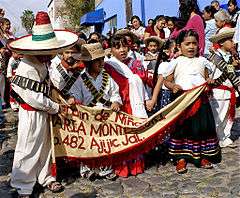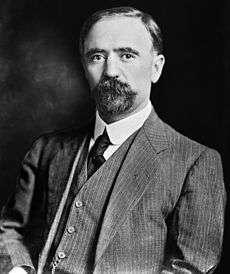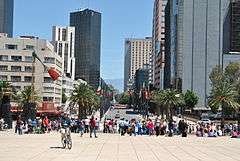Revolution Day (Mexico)
Revolution Day is an official Mexican government holiday, celebrated annually in Mexico on November 20, marking the start of what became the Mexican Revolution.
| Day of the Revolution | |
|---|---|
 Children from the Montessori Kindergarten singing "La Cucaracha" | |
| Official name | Día de la Revolución |
| Observed by | Mexico |
| Type | National |
| Significance | Anniversary of the start of the Mexican Revolution, one of five Fiestas Patrias |
| Celebrations | parades |
| Date | November 20 |
| Frequency | annual |
History

The Mexican Revolution brought the overthrow of liberal Army general Porfirio Díaz after 35 years as president of Mexico (1876-1911). In the 1910 presidential election, wealthy landowner Francisco I. Madero opposed Díaz. Díaz jailed Madero, who then escaped, issuing the Plan of San Luis Potosí on October 6, 1910. In that plan, Madero declared the results of the 1910 election fraudulent, nullified them, asserted that he was provisional president, and called for Mexicans to rise up against Díaz on November 20, 1910.[1] He wrote "Throw the usurpers from power, recover your rights as free men, and remember that our ancestors left us a heritage of glory which we are not able to stain. Be as they were: invincible in war, magnanimous in victory."

The commemoration is celebrated in Mexico as an official holiday.[2][3][4][5] Until 2006 and again from 2009 to 2013 the national celebrations were located at the Zocalo in Mexico City. Given the recent political and national tragedies that happened in 2014 the parades were called off at the aftermath of the 2014 Iguala mass kidnapping, (this was the case also in 2015), and the celebrations happened in the Campo Marte in the capital, thus pushing the national parade up to November 23, Navy Day, with only Mexican Navy personnel in attendance. Thus the national November 20 parades, during the remaining years of the Enrique Peña Nieto presidency, had now been replaced by state level ones, which have been held in major cities all over the nation as per tradition, but in a reduced basis, given recent cancellations due to protest actions on the said date in several state capitals. During the presidency of Andrés Manuel López Obrador, the traditional civil-military-athletic parade was finally reinstated in 2019.
The first crucial revolution during the 20th century was the Mexican Revolution.[6] The Mexican Revolution drove many Mexicans to migrate to America. This greatly affected many Mexican Americans as well as the United States.[6] Around 1 million legal migrants entered the United States throughout the revolution along with many other undocumented migrants.[6] This occurred four years before the introduction of a patrol between the borders.[6] The constitution created in 1917, in response to the revolution, established limits on the period of time politicians could be in power.[7] The Constitution also included labor reform laws that covered 8 hour workdays, abolished child labor, and established equal pay.[7]
Effect of revolution on gender
The revolution that occurred during 1910 greatly affected gender roles present in Mexico. However, it continued to create a strict separation between genders although both men and women were involved in the revolution. Women were involved by promoting political reform as well as enlisting in the military. Women who were involved in political reform would create reports that outlined the changes people wanted to see in their area. That type of activism was seen inside and outside of the cities. Women not only took political action but also enlisted in the military and became teachers to contribute to the change that they wanted to see after the revolution. Women were seen as prizes by many men involved in the military. Being involved in the military gave men a greater sense of superiority over women, which gave women the connotation of being a prize.[8] That idea often lead to violence against women, which meanwhile increased.[8] After the revolution, the ideas women contributed to the revolution were put on hold for many years. Women would oftentimes promote the ideas of establishing a greater justice system and creating ideals surrounded by democracy.[8] The revolution caused many people to further reinstate the idea that women were meant to be taking care of the household. Women were also put in the lower part of the social class because of this idea.[8]
Female soldiers during the Revolution
Oftentimes women who had been discarded by their families would join the military. Being involved in the military would lead to scrutiny amongst some male participants.[8] In order to avoid sexual abuse many women would make themselves appear more masculine.[8] They would also dress more masculine in order to gain more experience with handling weapons, and learning more about military jobs.[8]
María de Jesús González
An example of this is presented by María de Jesús González who was a secret agent involved in the Carranza's army. She would, oftentimes, present herself as a man in order to complete certain tasks assigned to her.[8] After she completed these tasks she would return to her feminine appearance.[8]
Rosa Bobadilla
Rosa Bodilla, however, maintained her feminine appearance throughout her military career. She joined the Zapata's military with her husband. When he died, she was given his title, which became "Colonel Rosa Bobadila widow of Casas."[8] She gave orders to men while continuing to dress as a female.
Amelia/o Robles
Amelia/o Robles was a deviation from the brief presentation of identifying masculine. After the revolution he continued to look like, and identify as a male for the rest of his life.[8] Amelia Robles abandoned her home in order to join the Zapata military. Throughout the war she began to assume a more masculine identity. After the war he did not return to his female appearance like others had. He carried on with his life as Amelio Robles, and remained to look as well as act masculine. He reestablished himself into the community as a male, and was recognized as a male on his military documents.[8]
Date
Article 74 of the Mexican labor law (Ley Federal del Trabajo) provides that the third Monday of November (regardless the date) will be the official Day of the Revolution holiday in Mexico. This was a modification of the law made in 2005, effective since 2006; before then, it was November 20 regardless of the day, and all schools gave extended holidays if the day was a Tuesday or Thursday.
See also
- Francisco I. Madero
- Mexican Revolution
- Plan of San Luis Potosí
- Revolution Day — in other countries.
References
- Stuart F. Voss, "Plan of San Luis Potosí". Encyclopedia of Latin American History and Culture vol. 4, p. 421. New York: Charles Scribner's Sons 1996.
- "Revolution Day - 20 de Noviembre - Día de la Revolución". Retrieved 30 June 2011.
- "November 20 Mexico Revolution Day Dia de la Revolución". Archived from the original on 6 September 2011. Retrieved 30 June 2011.
- "Revolución Mexicana - Días festivos y celebraciones en México" (in Spanish). Retrieved 30 June 2011.
- Talavera Franco, Ramón. "LA REVOLUCION MEXICANA" (in Spanish). Archived from the original on 4 July 2011. Retrieved 30 June 2011.
- Green, Susan Marie. "Mexican Revolution." Multicultural America: A Multimedia Encyclopedia, edited by Carlos E. Cortés and Jane E. Sloan, vol. 3, SAGE Reference, 2014, pp. 1453-1455. Gale eBooks, https://link-gale-com.butte.idm.oclc.org/apps/doc/CX3718500587/GPS?u=orov49112&sid=GPS&xid=9d559bec. Accessed 27 Sept. 2019.
- "Mexican Revolution." Worldmark Modern Conflict and Diplomacy, edited by Elizabeth P. Manar, vol. 2: Japanese Invasion of China to Yugoslav Wars, Gale, 2014, pp. 376-381. Gale eBooks, https://link-gale-com.butte.idm.oclc.org/apps/doc/CX3784400067/GPS?u=orov49112&sid=GPS&xid=d39922ad. Accessed 27 Sept. 2019.
- Cano, Gabriela. "Mexican Revolution and Sexuality." Global Encyclopedia of Lesbian, Gay, Bisexual, Transgender, and Queer (LGBTQ) History, edited by Howard Chiang, et al., vol. 2, Charles Scribner's Sons, 2019, pp. 1035-1039. Gale eBooks, https://link-gale-com.butte.idm.oclc.org/apps/doc/CX3662300236/GPS?u=orov49112&sid=GPS&xid=f3524ead. Accessed 27 Sept. 2019.
- Beemyn, Brett. "Bisexuality, Bisexuals, and Bisexual Movements." Encyclopedia of Lesbian, Gay, Bisexual and Transgender History in America, edited by Marc Stein, vol. 1, Charles Scribner's Sons, 2004, pp. 141-145. Gale eBooks, https://link-gale-com.butte.idm.oclc.org/apps/doc/CX3403600074/GPS?u=orov49112&sid=GPS&xid=62b35c98. Accessed 26 Sept. 2019.
- Martin, Justin A. "Bisexuality." Encyclopedia of Social Deviance, edited by Craig J. Forsyth and Heith Copes, vol. 1, SAGE Reference, 2014, pp. 61-64. Gale eBooks, https://link-gale-com.butte.idm.oclc.org/apps/doc/CX6501000037/GPS?u=orov49112&sid=GPS&xid=8807caa2. Accessed 27 Sept. 2019.
- Cano, Gabriela. "Mexican Revolution and Sexuality." Global Encyclopedia of Lesbian, Gay, Bisexual, Transgender, and Queer (LGBTQ) History, edited by Howard Chiang, et al., vol. 2, Charles Scribner's Sons, 2019, pp. 1035-1039. Gale eBooks, https://link-gale-com.butte.idm.oclc.org/apps/doc/CX3662300236/GPS?u=orov49112&sid=GPS&xid=f3524ead. Accessed 27 Sept. 2019.